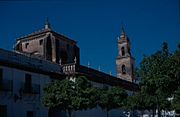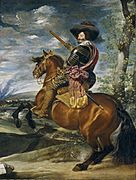Olivares, Spain facts for kids
Quick facts for kids
Olivares
|
|||
|---|---|---|---|
|
city
|
|||
|
|||
| Country | Spain | ||
| Autonomous community | Andalusia | ||
| Province | Seville | ||
| Comarca | Aljarafe | ||
| Municipality | Olivares | ||
| Area | |||
| • Total | 46 km2 (18 sq mi) | ||
| Elevation | 169 m (554 ft) | ||
| Population
(2018)
|
|||
| • Total | 9,390 | ||
| • Density | 204.1/km2 (529/sq mi) | ||
| Time zone | UTC+1 (CET) | ||
| • Summer (DST) | UTC+2 (CEST) | ||
Olivares is a city in the Province of Seville, Spain. It's home to about 9,400 people. The city is located in a region called Aljarafe, which is west of Seville. Olivares grew a lot after the important House of Olivares family was established there. This made it a key town in the Aljarafe area.
Contents
History of Olivares
Olivares is in a very old region once home to the Tartessos culture. This was one of Europe's earliest known civilizations. You can find ancient mounds from the Bronze and Iron Ages nearby. One of these, called Cerro de las Cabezas, might have been the old city of Laelia. Ancient writers like Pliny and Ptolemy mentioned this city.
These early settlements were near the Guadiamar river. This river might have been used by boats long ago. Cities like Laelia and Lastigi were likely important trading spots. During Roman times, the area was connected to a large aqueduct. This brought water from Tejada all the way to the Roman city of Itálica.
How Olivares Got Its Name
Olivares started as a small village called Estercolinas. It was built near a small stream. Later, it became known as villa de olivares, which means "town of olive fields." This is where the city gets its name. Olive trees have been grown here for hundreds of years. They are still a major source of income for the area, along with other crops like cereals.
Over time, Olivares grew bigger than the nearby town of Albaida. Another nearby town, Heliche, became empty in the early 1800s. Its people moved to Olivares. The stones from Heliche's church were even used to build the cemetery in Olivares.
The House of Olivares
The city is famous for the House of Olivares family. This family was started by Pedro Pérez de Guzmán in 1535. At that time, Olivares had only about 240 people.
In 1625, Gaspar de Guzmán became the first Count-Duke of Olivares. This meant he was both the Count of Olivares and the Duke of Sanlúcar. Later, this noble family joined with the powerful House of Alba. The House of Alba inherited all their lands. However, they sold some of these lands in the 1800s. The Duchess of Alba still owns a large country estate called La Pizana near Olivares.
Growth and Environmental Efforts
By 1751, Olivares had over 1,600 people. This number grew to almost 3,000 by 1888. In 1781, the city had only 12 streets and one main square. Today, it has about 150 streets!
In 1998, there was an environmental problem. A chemical spill from a nearby mine affected the Guadiamar river. This event led to the creation of a special wildlife corridor. It's called the Corredor Verde del Guadiamar (Green Corridor of the Guadiamar). This corridor helps protect nature along the river.
Country Estates (Cortijos)
The land around Olivares has many large country estates called cortijos. These used to be mostly forests with oak trees. Now, most of this land is used for farming. People grow olives, wheat, cotton, and corn.
Many of these lands were once owned by the powerful Dukedom. Later, they became part of the House of Berwick & Alba. However, much of this land was sold in the 1800s. This happened because the House of Alba faced financial difficulties and high taxes.
Here are some of the important cortijos that still exist today:
- La Coriana: This estate is north of Olivares. It was known for its fountain.
- Montijos: This estate is mainly planted with olive trees.
- La Bartola: This was another large land owned by the House of Alba.
- Bonal: Located next to the Guadiamar river.
- Soberbina: One of the oldest and largest estates in the area.
- San Antonio: This is one of the largest estates, next to the Guadiamar. It gives its name to the San Antonio Tower.
- Conti: The road between Olivares and Gerena runs through this estate.
- La Alegría: This used to be a forest area, but now it's farmland.
Gallery
-
Gaspar de Guzmán, Count-Duke of Olivares, as portrayed by Diego Velázquez
See also
 In Spanish: Olivares para niños
In Spanish: Olivares para niños








